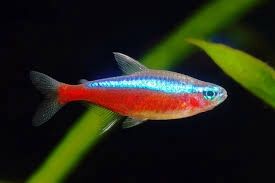Cardinal Tetra
Cardinal Tetra (Paracheirodon axelrodi) Care Guide
The Cardinal Tetra is a stunning and peaceful schooling fish, instantly recognizable by its bright neon blue stripe and vivid red belly that runs the entire length of its body. Loved by aquarists worldwide, these vibrant fish bring life and color to any planted community tank.
Tank Requirements
-
Minimum Tank Size: 60 litres
-
Temperature: 24–28°C
-
pH: 5.5–7.0
-
GH: 1–6
-
KH: 0–4
-
TDS: 80–150 ppm
They thrive in soft, slightly acidic water with dim lighting and a gentle current. Add tannins (from driftwood or Indian Almond Leaves) to mimic their natural Amazon habitat.
Habitat Setup
Create a peaceful, natural setting with:
-
Dense live plants like Java Fern, Amazon Sword, and Cryptocoryne
-
Driftwood and leaf litter for shelter
-
Dark substrate to enhance their striking colors
Keep them in groups of at least 6–10 — larger schools feel safer and display more vivid colors.
️ Feeding
Cardinal Tetras are omnivores and appreciate variety in their diet:
-
High-quality micro pellets or flakes
-
Frozen or live foods (daphnia, brine shrimp, bloodworms)
-
Crushed spirulina flakes for extra nutrition
Feed small amounts 1–2 times a day — they have tiny stomachs!
Tank Mates
Peaceful and sociable, Cardinal Tetras do best in calm community setups.
Ideal companions:
Corydoras, Otocinclus, small Rasboras, Dwarf Gouramis, and peaceful shrimp.
Avoid fin-nipping or large predatory fish.
Breeding
Breeding can be challenging, as it requires very soft, acidic water (pH 5–6) and low light conditions. They scatter eggs among fine plants or moss. Fry are tiny and need infusoria as a first food.
Interesting Fact
In the wild, Cardinal Tetras come from blackwater rivers of the Amazon Basin, where sunlight barely reaches the forest floor — their neon stripes evolved to help them see and stay together in the dim, tea-colored waters!
Reference: Bubbly Fish – Creating underwater wonders

